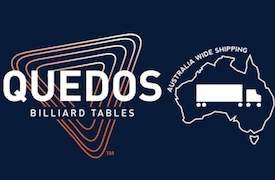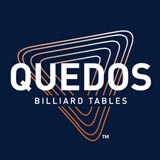The cloth on your QUEDOS table is made by Hainsworth in England from pure 100% wool. It has a fined grained finish called “nap” which when rubbed the wrong way stands up, making the pile uneven.
Care of the cloth is extremely important. The major causes of cloth care are chalk dust, dirt and abusive player actions. Dust covers are highly recommended to prolong the life of the cloth as strong light and dust and chalk particles can fade or break down wool fibres.
Regular brushing (ideally after every session of play) with the table brush supplied with your table is essential in maintaining good table performance and appearance as well as making the cloth last significantly longer.
When brushing the table use short, sharp straight strokes – brush with the nap, from the “D” end to the spot end. Brush down the table in one straight line with the next ‘run’ to slightly overlap the previous, lifting the brush upwards at the end of each stroke to lift up the dust from the cloth. Remember to brush under and around the top of the cushions in the direction of the nap. Ideally use a hand held vacuum to collect the brushed particles. Otherwise, carefully run the brush across the bottom of the cushion to brush the debris into the corner pockets.
You also may wish to vacuum your table occasionally to more thoroughly remove the chalk dust that has accumulated in the cloth. This is again done in one direction only, the same as brushing. Vacuuming can stretch the cloth so it is recommended that this be done infrequently – say every 6 months.
Spills on the cloth should receive prompt attention. Firstly, soak up the spilt liquid with a sponge. Saturate the affected area with water or soda water and then absorb as much of the liquid as possible with a dry towel or sponge. Allow the area to dry thoroughly (a hair dryer can be used to speed up the drying process) and then apply a moistened cloth to further absorb any possible sugar content of the beverage. If the stain remains after drying, remove it with a delicate fabric detergent suitable for use with pure wool material, such as Martha Gardener’s Wool Mix.
Preventative rules are the best maintenance: never permit the table to be used for purposes other than playing, and keep food and drink away from the table. Never drop balls onto the cloth or toss coins, dice or equipment on the table because such action can crush the wool fibres which develop eventually into worn spots or holes. Do not chalk cues over the table. Dust builds up and acts as an abrasive.
As your cue tips become worn have them replaced. If the brass ferrule at the top of your cue is exposed it may cut small holes in the cloth. White-ish chalk-like marks can be the result of striking the cue ball too low and grazing the cloth at the same time.



